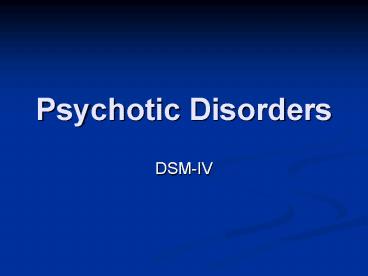Psychotic Disorders - PowerPoint PPT Presentation
1 / 16
Title:
Psychotic Disorders
Description:
Psychotic Disorders. DSM-IV. Psychosis. Psychosis is a condition ... Tardive dyskinesia serious side effect. Clozaril (atypical) Case Management. Family Therapy ... – PowerPoint PPT presentation
Number of Views:48
Avg rating:3.0/5.0
Title: Psychotic Disorders
1
Psychotic Disorders
- DSM-IV
2
Psychosis
- Psychosis is a condition characterized by a loss
of contact with reality. - Hallucinations false perceptions
- Delusions false beliefs
3
Examples of Hallucinations and Delusions
- Hallucinations
- Hearing voices
- Seeing visions
- Experiencing odd tastes, smells
- Experiencing odd feelings
- Delusions
- Persecution
- Grandeur
- Somatic
- Jealousy
- Erotomania
- Thought control
- Behavior control
- Thought withdrawal
4
Psychoses may be caused by
- Drugs e.g., LSD, Amphetamines, Cocaine
- Brain Diseases e.g., Alzheimers Disease
- Brain Injuries e.g., trauma, stroke
- Extreme stress e.g., war, kidnapping,
- Bipolar and major depressive disorders
- Schizophrenia--most common cause
5
Some Recent Cases
- Ted Kaczynski--the unabomber
- Mark David Chapman--killed John Lennon
- John Hinckley--shot President Reagan
- Andrea Yates--drowned her five children
- Note most schizophrenics are not violent
6
A few facts about schizophrenia
- Usually diagnosed in late teens/early 20s
- Means split mind Eugen Bleuler
- Affects approximately 1 of people
- Men have more severe cases
- 10-15 commit suicide
- More common among the poor
7
Diagnosing Psychiatric Disorders
- All psychiatric disorders including schizophrenia
are diagnosed on the basis of clusters of
symptoms - There is no brain scan, no urine test, no blood
test, no cerebral spinal fluid test that can be
used to diagnose schizophrenia
8
Positive and Negative Symptoms
- Positive
- Hallucinations
- Delusions
- Disordered speech
- Bizarre behavior
- Good response to drugs, normal brain ventricles,
limbic system abnormalities
- Negative
- Emotionally flat
- Poverty of speech
- Associality
- Apathy
- Avolition
- Frontal lobe abnormalities, enlarged ventricles,
variable response to drugs
9
Diagnostic Criteria for Schizophrenia
- Delusions
- Hallucinations
- Disorganized Speech
- Disorganized or catatonic behavior
- Negative Symptoms (deficits)
- Two or more of the above must be present for at
least one month and some disturbance for six
months - Significant impairment in social/occupational
functioning
10
Disorganized Speech
- Disorder of thought form
- Loose Associations
- Thought derailment
- Neologisms (making up words)
11
Etiology (Causal Factors)
- No one factor can fully explain
- Very good evidence for genetic transmission of a
predisposition - Probably polygenic
- Suspect chromosomes 22, 6, 8, and 1
- Some evidence for other biological factors
12
Genetic Studies
- Family studies risk increases as number of
shared genes increases - Twin studies concordance rate higher in
identical than fraternal twins - Adoption studies biological relatives show
increased risk
13
Other suggested causal factors
- Prenatal viral infections, esp. 4 -7 month
- Rh incompatibility between mother and baby
- Early nutritional deficiencies
- Birth complications
14
Other Biological Aspects
- Enlarged ventricles
- 3 reduction in overall brain volume
- Amygdala, frontal lobes, temporal lobes,
hippocampus, thalamus - Most brains look normal
- Dopamine
- Glutamate
15
Treatment
- Antipsychotic medications
- Thorazine (conventional, typical)
- Tardive dyskinesia serious side effect
- Clozaril (atypical)
- Case Management
- Family Therapy
- Psychotherapy usually NOT appropriate
16
Conclusions
- Schizophrenia affects about 1 of the worlds
population and disables more people than any
other physical or mental disorder. - The cost to society is enormous. Direct medical
care in the U. S. is estimated to be 20 billion
dollars per year (Torrey, 1995). Loss of
productivity is incalculable. - There is excellent research going on in many
areas-- neuroscience, genetics, molecular
biology, psychology, pharmacology, and other
areas. - We should have the genes identified in the next
five years.































